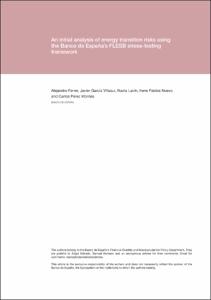Registro completo de metadatos
| Campo DC | Valor |
|---|---|
| dc.contributor.author | Ferrer, Alejandro |
| dc.contributor.author | García Villasur, Javier |
| dc.contributor.author | Lavín, Nadia |
| dc.contributor.author | Pablos, Irene |
| dc.contributor.author | Pérez Montes, Carlos |
| dc.coverage.spatial | España |
| dc.date.accessioned | 2022-06-01T11:34:13Z |
| dc.date.available | 2022-06-01T11:34:13Z |
| dc.date.issued | 2021-11-30 |
| dc.identifier.uri | https://repositorio.bde.es/handle/123456789/21152 |
| dc.description | Artículo de revista |
| dc.description.abstract | This article contains the Banco de España’s initial analysis of the energy transition risks’ impact on the banking sector, using its Forward Looking Exercise on Spanish Banks (FLESB) in-house stress-testing framework. Different macroeconomic scenarios, linked to higher prices and the extended coverage of the emissions trading system, with a three-year time horizon are considered. In this exercise, the probability of default of the business lending portfolios was modelled with a high level of granularity, by enterprise size and by sector, to capture these transition risks’ uneven impact on them. The other risk factors and balance sheet and income statement items are also projected consistently with the macroeconomic scenarios in order to obtain estimates for the institutions’ profitability and solvency. Overall, the scenarios have a moderate impact on the credit quality of business lending; however, those sectors with greater greenhouse gas emissions are significantly more affected. Nonetheless, the exposures to these more affected sectors account for a relatively limited percentage of the Spanish banking sector’s total lending. As a result, the ultimate impact on profitability is also muted. While the analysis conducted is an initial and partial approach to measuring transition risk, by focusing on the short term, it helps reduce uncertainty over the costs of the energy transition process. |
| dc.format.extent | 21 p. |
| dc.language.iso | en |
| dc.publisher | Banco de España |
| dc.relation.ispartof | Financial Stability Review / Banco de España, 41 (Autumn 2021), p. 23-43 |
| dc.relation.hasversion | Versión en español 123456789/19363 |
| dc.rights | Reconocimiento-NoComercial-CompartirIgual 4.0 Internacional (CC BY-NC-SA 4.0) |
| dc.rights | In Copyright - Non Commercial Use Permitted |
| dc.rights.uri | https://creativecommons.org/licenses/by-nc-sa/4.0/deed.es_ES |
| dc.rights.uri | http://rightsstatements.org/vocab/InC-NC/1.0/ |
| dc.subject | Climate-related risk |
| dc.subject | Transition risk |
| dc.subject | Stress tests |
| dc.subject | Probability of default |
| dc.subject | Profitability |
| dc.subject | Solvency |
| dc.title | An initial analysis of energy transition risks using the Banco de España’s FLESB stress-testing framework |
| dc.type | Artículo |
| dc.identifier.bdebib | 000472869 |
| dc.identifier.bdepub | FIER-2021-41-2 |
| dc.subject.bde | Regulación y supervisión de instituciones financieras |
| dc.subject.bde | Energía y política energética |
| dc.subject.bde | Riesgos y liquidez |
| dc.subject.bde | Instituciones crediticias de depósito |
| dc.publisher.bde | Madrid : Banco de España, 2021 |












